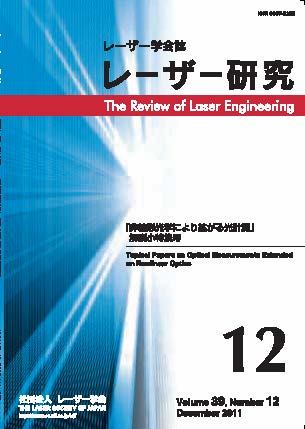All issues

Volume 46, Issue 12
Special Issue on Remote Power Transmission Technologies Using Laser
Displaying 1-7 of 7 articles from this issue
- |<
- <
- 1
- >
- >|
Special Issue on Remote Power Transmission Technologies Using Laser
Special Issue
Laser Review
-
Tomoyuki MIYAMOTO2018Volume 46Issue 12 Pages 686-
Published: 2018
Released on J-STAGE: December 18, 2020
JOURNAL FREE ACCESSIn this special issue, the characteristics of the system and the device, the necessary technology, and the latest trends of the optical wireless and the optical fiber power transmission which utilize the energy of the laser light remotely as electric power are discussed. It is easy to imagine the principle and features of power transmission by laser light. However, this technical field is an unexplored laser application field which has not been sufficiently developed the system and application. It should be noted that remote wireless power transmission may become one of important application fields of lasers in the future.View full abstractDownload PDF (210K) -
Motoharu MATSUURA2018Volume 46Issue 12 Pages 688-
Published: 2018
Released on J-STAGE: December 18, 2020
JOURNAL FREE ACCESSIn future radio-over-fiber networks, a huge number of distributed remote antenna units are required to provide various kinds of communication services. Power-over-fiber, which delivers the power required for driving distributed remote antenna units into optical fibers, is an attractive technology to provide cost-effective installation, operation, and maintenance and achieve the power saving in the entire networks. This paper introduces our recent works on power-over-fiber technologies for remote antenna units in radio-over-fiber networks.View full abstractDownload PDF (558K) -
Tomoyuki MIYAMOTO2018Volume 46Issue 12 Pages 693-
Published: 2018
Released on J-STAGE: December 18, 2020
JOURNAL FREE ACCESSUnlike the progress of wireless communication, power transmission technology to the equipment lags. The existence of wiring and its connections greatly restricts the location, the installation, the maintenance, and the configuration of equipment. Optical wireless power transmission (OWPT) is a key technology for expanding the field of wireless usable equipment since it is small and provides long distance transmission. As a demonstration of a prototype of the OWPT system, we applied a vertical cavity surface emitting laser (VCSEL) array to achieve electric output of 10 W from a solar cell at a transmission distance of 2 m. We applied uniform beam irradiation on the solar cell using a lens system, a series-connected VCSEL array module and a GaAs solar cell to the prototype. Power transmission efficiency of up to 16% was obtained. Future prospects are also discussed.View full abstractDownload PDF (1527K) -
Fumiaki TANAKA, Ryota JOMEN, Mitsutaka IKEDA, Kousei KIRYU, Hideo ...2018Volume 46Issue 12 Pages 698-
Published: 2018
Released on J-STAGE: December 18, 2020
JOURNAL FREE ACCESSThe power conversion efficiencies of such single-junction III-V solar cells as GaAs and GaInP for wireless power transmission were investigated by changing the wavelength and the incident power of a laser diode. The GaAs solar cell exhibited the highest conversion efficiency of 52.7% at a laser wavelength of 824 nm, and the GaInP solar cell exhibited the highest conversion efficiency of 48.0% at a laser wavelength of 520 nm. For each solar cell, the conversion efficiency peaked at an optimal incident laser wavelength. We found that the conversion efficiency strongly depends on the external quantum efficiency of each solar cell.View full abstractDownload PDF (607K) -
Takeo MARUYAMA2018Volume 46Issue 12 Pages 702-
Published: 2018
Released on J-STAGE: December 18, 2020
JOURNAL FREE ACCESSWe focused to develop a beam steering system to track high-speed object movement using the Galvano mirror with CMOS camera. To recognize the special characteristic of the object, color-filtering method is chosen. As the results, the beam steering system can be used to direct the beam to follow object movement speed up to 35˚/s. Maximum error position between the central point of object recognition with laser beam spot using color-filtering method without prediction methods is around 2o. To decrease the error position, the prediction method added with system delay factor attached to the color filtering method, this method can decrease the error position less than 0.4o. For OWPT application, we implemented this method to drive small car using this method.View full abstractDownload PDF (947K) -
Takashi KONDO, Yuji SHIRAI, Masaaki KITSUNAI, Junichiro HAYAKAWA, ...2018Volume 46Issue 12 Pages 706-
Published: 2018
Released on J-STAGE: December 18, 2020
JOURNAL FREE ACCESSVertical-Cavity Surface-Emitting Laser (VCSEL) arrays are very promising light sources for heating, sensor applications, and optical wireless power transmission. Arrays have hundreds of VCSELs, a few bonding pads, and all of the VCSELs are connected to the same electrode to simultaneously emit light. Their advantages include a higher output power than watts, a high power conversion efficiency exceeding 40%, and so on. Recently arrays with hundreds of VCSELs that can emit light individually are needed for such applications without mechanical devices as MEMS and polygon mirrors. But conventional VCSEL arrays need the same number of bonding pads, gold wires, substrate wirings, and IC driver terminals as emitters, thus taking up more space and increasing application costs. We propose an all monolithically integrated self-scanning VCSEL array that can individually emit light, even though it has only five bonding pads regardless of how many emitters it has.View full abstractDownload PDF (1650K) -
Tetsuya TAKEUCHI, Motoaki IWAYA, Satoshi KAMIYAMA, Isamu AKASAKI2018Volume 46Issue 12 Pages 711-
Published: 2018
Released on J-STAGE: December 18, 2020
JOURNAL FREE ACCESSThis paper describes the status and prospects of GaN-based blue laser diodes and solar cells in terms of using optical wireless power transmission systems. Reported values of the power conversion efficiency, which is one of the most important characteristics of the emitters and the detectors in the systems, were summarized. These are the reported values: about 40% for blue edge-emitting laser diodes, less than 10% for blue vertical-cavity surface-emitting lasers, and about 30% for solar cells at 390‒400 nm wavelength. Since optical wireless power transmission with blue lasers is beginning to attract attention, device developments towards such an application will be pursued.View full abstractDownload PDF (391K)
- |<
- <
- 1
- >
- >|